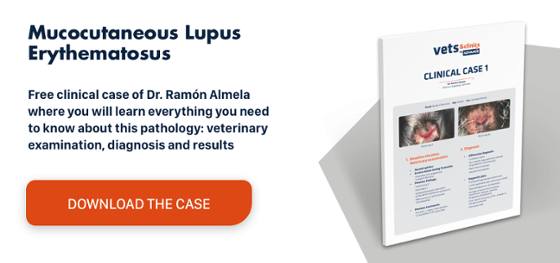What is necrolytic migratory erythema?
Aetiology of necrolytic migratory erythema
This is a skin disease that only affects animals with chronic liver disease or glucagon-secreting pancreatic tumours.3
The exact pathogenesis is unknown, but it is believed that increased amino acid catabolism in the liver reduces the concentration of amino acids and proteins in the epidermis, resulting in the disease’s characteristic skin lesions. It is uncommon in dogs and rarely observed in cats, with a higher incidence in elderly dogs.3
Clinical signs
The skin lesions are characterised by bilateral erythema, ranging from minimally to intensely pruritic with scales, scabs, erosions and ulcers in the lower limbs and around the mouth and ears. The lesions may also affect the elbows, bladder, hocks, external genitalia, abdomen and oral cavity. The paw pads usually present hyperkeratosis with cracks and ulceration. There may be an evident limp secondary to paw pad lesions. When it courses concurrently with diabetes mellitus, patients may also present polyuria and polydipsia.3
Differential diagnosis
The differential diagnosis includes pemphigus foliaceus, systemic lupus erythematosus, zinc-responsive dermatosis, cutaneous epitheliotropic lymphoma, dermatophytosis, pyoderma, demodicosis and drug eruption.2,3
Diagnosis
The patient’s history and clinical symptoms are usually enough to suggest the diagnosis, but it must be confirmed through a histopathological examination of biopsy samples.2
A blood count can detect neutrophilia or normocytic, normochromic, nonregenerative anaemia.3
Lab analyses may reveal low plasma amino acids and elevated serum alkaline phosphatase and alanine aminotransferase. Blood glucose may be elevated and so could glucagon if there is a glucagonoma; the results can vary for other cases.2
An abdominal ultrasound may show evidence of liver disease, a pancreatic tumour or liver metastases.3
A liver biopsy will reveal evidence of chronic hepatitis.2
Finally, dermatohistopathology performed on the initial lesions returns diagnostic findings of intense, diffuse parakeratotic hyperkeratosis with considerable intracellular and intercellular oedema, keratinocyte degeneration in the upper epidermis and basal cell hyperplasia. There may be mild, superficial perivascular dermatitis with signs of secondary infection by bacteria, dermatophytes or yeasts.3
Treatment
There is no specific curative therapy. The first treatment applied, involving corticosteroids and antibiotics, usually gives the best results; however, improvements are temporary as the treatment reduces the inflammatory component in the dermis and any secondary bacterial infections. Ketoconazole can also be effective.4
Surgical excision is the treatment of choice when a glucagonoma has been diagnosed. Epidermal metabolic necrosis due to other causes is associated with a range of serious internal diseases.2
If the problem is secondary to liver disease, the cause must be identified and corrected (e.g., hepatotoxicity due to anticonvulsant use). Certain antioxidants may be given for symptomatic improvement of liver function:3
- Oral S-adenosylmethionine at 18–22 mg/kg/day (90 mg in small animals, 225 mg for larger animals).
- Ursodiol, 10 mg/kg/day taken orally.
- Vitamin E, 400 IU taken orally every 12 hours.
In dogs with liver fibrosis, colchicine (0.03 mg/kg/day, orally) helps retard the progress of fibrosis.3
Some studies have highlighted how the administration of amino acids to dogs improves skin lesions.4


